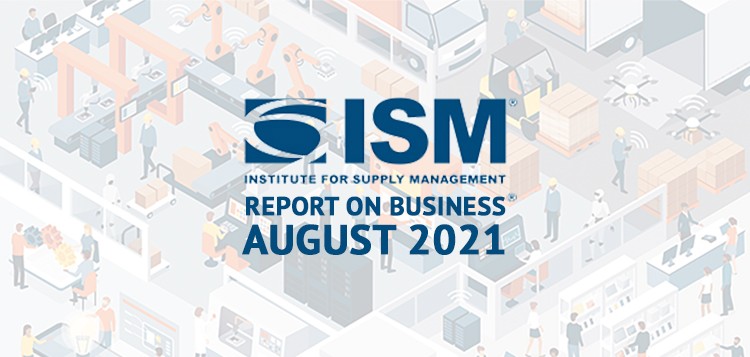COVID-19 Creeps Back into the August 2021 Manufacturing ISM® Report On Business®

According to benchmark data from the August 2021 Manufacturing ISM® Report On Business®, stability in the manufacturing sector continued through August. The individual metrics in the report show relative volatility, but the ISM itself shows consistency: a healthy plateau well into expansion territory. But for the first time this year, executive sentiment surrounding COVID-19 is forward-looking rather than retrospective. Concerns about the Delta Variant and the global implications of rising cases have manufacturers bracing for more turbulence.
A closer look at the numbers
Despite an almost imperceptible change in overall PMI from July to August (+0.4%), the individual vectors measured by the report showed much more flux. The biggest movers were inventories and customer inventories, which both rose more than 5%. Prices dropped more than 6% to alleviate mounting fears of inflation, but employment and supplier deliveries both tracked downward — shedding 4% and 3% respectively.
Two important trends took shape in August among inventory figures and employment. Employment slid back into contraction territory after showing signs of growth earlier in the year. Inventories have rocketed into expansion territory, signaling cautious uncertainty within the industry as producers try to anticipate growing demand.
Registering 59.9% in August, the PMI is a perfect representation of the 12-month average. Indications show manufacturing remains healthy and burgeoning post-pandemic.

Fears about COVID-19 are on the rise
While most see 2021 as a post-pandemic year, manufacturing executives acknowledge the world is still in the thick of it. Fears of COVID-19 are reemerging, and executives are cautious about the Delta Variant and rising rates of infection across the country and around the world; “Some factories have been impacted by COVID-19 cases. Malaysian government says factories can operate at only 60 percent of capacity.”
Manufacturers are unsure of how to proceed. Should they return to partial occupancy and social distancing? Reinforce mask mandates? Reinstitute quarantine policies? Mandate vaccinations? Conflicting state and federal guidelines have put manufacturers in a tough position at a time when supply chain constraints and rising rates are already amplifying the pressure.

COVID-19 continues to hit supply chains
The other chief obstacle revealed in the August ISM is future resource shortages. The semiconductor shortage from Asia is still wreaking havoc for supply lines across numerous industries, and executives fear similar disruptions as supply chains continue to suffer strain heading into the latter months of 2021; “Business is strong. Part shortages are our largest business constraint. We cannot fulfill orders to customers in reasonable lead times. Now booking out into 2022, and it will get worse as we hit our cyclical high demand in the fourth quarter.”
COVID-19 remains central to the disruption. Suppliers unable to maintain inventories pass along their burden to producers already facing high demand. And while prices have retreated from historic highs, other key variables need fortifying for supply chains to rally. As long as the pandemic persists, true recovery seems unlikely. Domestic producers agree and are taking proactive steps to mitigate future effects. Will it be enough to keep manufacturing stable through the end of 2021? Time and future ISM reports will tell.